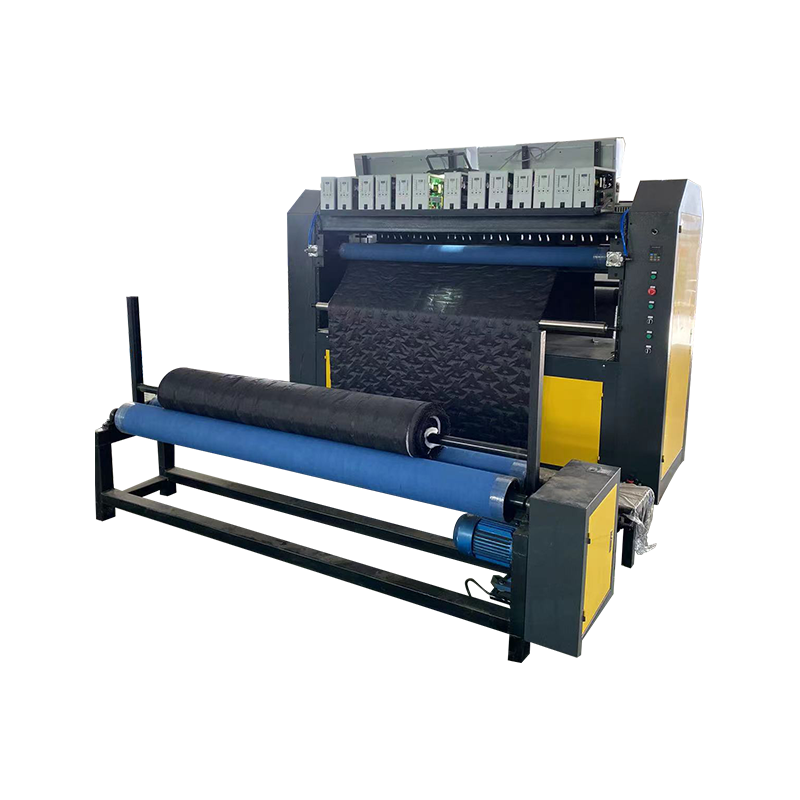
Automatic ultrasonic quilting machines are designed to handle real-time adjustments during the quilting process through a combination of advanced sensors, feedback systems, and automated controls. These features ensure that the machine can adapt to variations in fabric tension, alignment, and other factors that may affect the quality of the quilted product. Here’s how these machines typically manage real-time adjustments:
1. Sensor-Based Monitoring
Tension Sensors : The machine is often equipped with tension sensors that monitor the tension of the fabric as it moves through the quilting process. If the tension becomes too high or too low, the machine can automatically adjust the speed of the rollers or feed mechanisms to maintain consistent tension.
Alignment Sensors : Optical or laser sensors can detect if the fabric is misaligned as it moves through the machine. If misalignment is detected, the machine can make real-time adjustments to the position of the fabric or the quilting head to ensure proper alignment.
Temperature Sensors : Ultrasonic bonding generates heat, and temperature sensors can monitor the heat levels to prevent overheating or damage to the fabric. If the temperature exceeds safe levels, the machine can reduce the ultrasonic energy or pause the process momentarily.
2. Feedback Control Systems
Closed-Loop Feedback : Many modern ultrasonic quilting machines use closed-loop feedback systems. This means that the machine continuously monitors its performance (e.g., fabric tension, alignment, speed) and compares it to predefined parameters. If deviations are detected, the system automatically makes adjustments to bring the process back in line with the desired settings.
Pressure Feedback : Ultrasonic bonding requires precise pressure between the horn and the anvil. Pressure sensors can provide real-time feedback to ensure that the correct amount of force is applied during the bonding process. If the pressure deviates, the machine can adjust the pressure dynamically.
3. Automated Pattern Adjustment
Real-Time Pattern Correction : Some advanced ultrasonic quilting machines have the ability to adjust patterns on the fly. For example, if the fabric stretches or shifts slightly during the quilting process, the machine can recalibrate the pattern to ensure that the design remains consistent and aligned.
Digital Pattern Tracking : Machines with digital pattern tracking can monitor the progress of the quilting design and make micro-adjustments to ensure that the pattern is applied accurately across the entire fabric. This is especially useful for complex or large-scale designs.

4. Adaptive Speed Control
Variable Speed Control : The machine can adjust its quilting speed based on the type of fabric being processed or the complexity of the pattern. For example, if the machine detects thicker or more delicate fabrics, it may slow down to ensure proper bonding without damaging the material.
Dynamic Speed Adjustment : In some cases, the machine may need to slow down or speed up in response to real-time conditions, such as fabric bunching or uneven feeding. Adaptive speed control allows the machine to maintain consistent quality even when unexpected issues arise.
5. Ultrasonic Energy Management
Energy Modulation : The ultrasonic generator can modulate the amount of energy delivered to the horn based on the thickness and type of fabric being processed. If the machine detects thicker areas (e.g., seams or multiple layers), it can increase the ultrasonic energy to ensure proper bonding. Conversely, it can reduce energy for thinner or more delicate fabrics to prevent damage.
Frequency Adjustment : Some machines allow for real-time adjustment of the ultrasonic frequency to optimize bonding for different materials. This ensures that the ultrasonic waves are tuned to the specific properties of the fabric being quilted.
6. Error Detection and Correction
Fault Detection : The machine can detect faults such as skipped stitches, incomplete bonding, or fabric jams. When a fault is detected, the machine can either stop the process to alert the operator or attempt to correct the issue automatically.
Self-Correction Mechanisms : In some cases, the machine can self-correct minor issues without stopping the quilting process. For example, if a slight misalignment is detected, the machine can adjust the position of the fabric or the quilting head to correct the issue before continuing.
7. Operator Alerts and Manual Overrides
Real-Time Alerts : If the machine encounters a problem that it cannot resolve automatically, it can alert the operator via visual or auditory signals. The operator can then intervene to correct the issue manually.
Manual Override : While the machine handles most adjustments automatically, operators can still take manual control if needed. This is useful for situations where the machine’s automatic adjustments may not be sufficient or when custom adjustments are required.
8. Integration with IoT and Industry 4.0
Remote Monitoring and Adjustments : Some advanced ultrasonic quilting machines are integrated with IoT (Internet of Things) platforms, allowing operators to monitor the machine’s performance remotely. Real-time data can be sent to a central dashboard, where operators can make adjustments or receive alerts about potential issues.
Predictive Maintenance : IoT-enabled machines can also predict when certain components (e.g., the ultrasonic horn or booster) may need maintenance or replacement. This helps prevent downtime and ensures that the machine continues to operate at peak efficiency.
Copyright © ChangZhou AoHeng Machinery Co., Ltd. All Rights Reserved

 English
English 中文简体
中文简体 русский
русский Español
Español